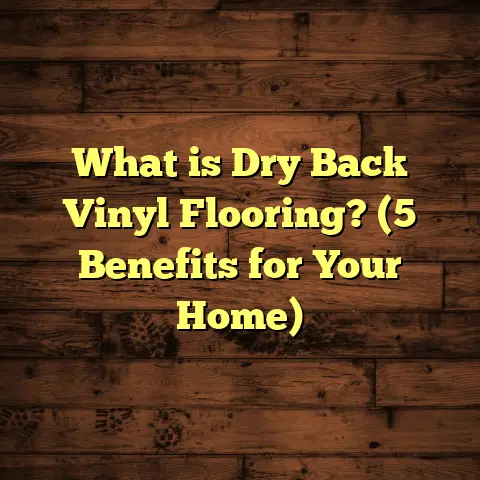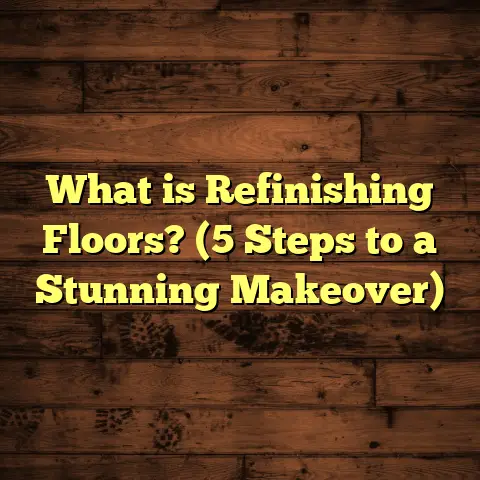What is Laminate Flooring Used For? (5 Benefits You Must Know)
What if you could have a floor that looks just like real hardwood — warm, inviting, and stylish — but doesn’t cost a fortune or require constant upkeep? Imagine a floor that can handle the chaos of everyday life — spills, pets, kids playing — yet still looks amazing years later. What if installing that floor was so straightforward you could even do it yourself on a weekend? Sounds too good to be true, right? That’s exactly the kind of experience I’ve had many times over with laminate flooring, and I want to share with you why I think it’s such a great solution for so many homes.
I’ve worked with hundreds of clients across different types of projects — from small condo renovations to large family homes and commercial spaces. Over time, laminate flooring has proven itself again and again as a smart, affordable, and practical choice. Let me walk you through what laminate flooring really is, what it’s used for, and why I believe it deserves a spot in your home or project.
What Exactly Is Laminate Flooring?
The term “laminate” can confuse some people because it sounds technical or complicated. But at its core, laminate flooring is a type of flooring made by layering several materials together to create a durable surface that mimics natural wood or stone.
Here’s how it breaks down:
- Core Layer: The foundation is typically made from high-density fiberboard (HDF). This is a compressed wood fiber material that gives the flooring strength and stability. It’s engineered to resist warping.
- Design Layer: On top of the core is a high-resolution photographic layer that shows the pattern or image of wood grain, stone texture, or tile designs. This layer is what makes laminate look incredibly realistic.
- Wear Layer: Finally, there’s a clear protective coating made from melamine resin or aluminum oxide. This wear layer is tough and scratch-resistant, protecting the design from damage caused by foot traffic, pets, furniture, or spills.
Think of laminate flooring as a sandwich: the core gives support, the design gives beauty, and the wear layer gives protection. All these layers are fused together under heat and pressure to create planks or tiles that click-lock together during installation.
How Laminate Differs From Hardwood or Engineered Wood
You might wonder how laminate compares to hardwood or engineered wood floors since they can look similar at first glance.
- Hardwood Flooring: Made from solid planks cut directly from trees. It’s prized for its natural grain and ability to be sanded and refinished multiple times. But hardwood is expensive, can dent easily, and is sensitive to moisture.
- Engineered Wood Flooring: Has a real wood veneer on top but uses plywood layers underneath for stability. It’s more resistant to moisture than hardwood but still costs more than laminate.
- Laminate Flooring: Contains no real wood on the surface; instead, it uses a printed image layer. It cannot be refinished but typically costs much less and offers superior scratch resistance.
In my experience, laminate bridges the gap between affordability and appearance better than most options.
What Is Laminate Flooring Used For? Five Benefits You Must Know
I’ve found that knowing what laminate flooring is good for helps you decide if it’s right for your needs. Here are five key benefits I’ve seen firsthand in various projects:
1. It’s Tough Enough for High-Traffic Areas
One of the biggest reasons I recommend laminate is its ability to handle heavy use without showing wear quickly. When I worked on a community center renovation recently, we installed over 3,000 square feet of laminate in hallways and activity rooms where kids ran around all day.
The wear layer on laminate resists scratching better than many hardwood finishes. According to research by the National Wood Flooring Association (NWFA), laminate surfaces score 2-3 times higher in scratch resistance tests compared to traditional wood floors.
For example, their tests showed that laminate could withstand sharp objects like keys or pet claws without visible damage after repeated contact — something hardwood struggled with.
Over time, this durability keeps laminate floors looking fresh in places like:
- Family rooms
- Entryways
- Kitchens
- Playrooms
- Commercial spaces such as offices or retail stores
In my own home, my laminate flooring has survived dog nails, toy cars racing across the floor, and even dropped glassware — all without noticeable scratches. That kind of toughness is hard to find at this price point.
2. It’s Affordable Without Sacrificing Style
If you’ve priced out hardwood flooring recently, you know it can quickly break your budget. Even engineered wood can be pricey depending on the species and finish. Laminate flooring usually comes at a fraction of that cost while offering a surprisingly authentic look.
On average:
| Flooring Type | Average Installed Cost per Square Foot |
|---|---|
| Laminate | $2.50 – $5 |
| Hardwood | $6 – $12+ |
| Engineered Wood | $4 – $8 |
| Vinyl | $2 – $7 |
| Tile | $5 – $15 |
This price difference means you can afford high-end styles or cover more area within your budget when you choose laminate.
I recall helping a homeowner who wanted the warmth of natural oak floors but couldn’t justify the hardwood price tag on their whole 1,200 sq ft home. We chose a mid-range oak-look laminate with beveled edges to mimic real planks. The results blew everyone away — friends couldn’t tell it was laminate unless they looked closely.
Plus, with advances in printing technology and embossing techniques, modern laminates can imitate wood knots, grain variations, and even hand-scraped textures that once were only possible with expensive hardwoods.
3. Installation Is Fast and Easy — Perfect for DIY or Tight Deadlines
I’ve been on many jobs where laminate was chosen specifically because it can be installed quickly and cleanly. Unlike hardwood floors that require nailing or gluing down each plank — which is time-consuming — most laminate uses a floating floor system.
This means:
- Planks click-lock together without nails or adhesives.
- The floor “floats” over the existing subfloor or underlayment.
- Installation can be completed in hours rather than days.
On one recent project at a vacation rental home, we replaced old carpet with laminate in less than two days total — including removal and cleanup. The property owner was thrilled because it shortened turnaround time between bookings.
For homeowners wanting to tackle projects themselves, this ease of installation cuts down on contractor costs and allows weekend warriors to feel proud of their handiwork.
4. Maintenance Is Simple — Keep It Looking New With Minimal Effort
One thing I always ask clients is how much time they want to spend cleaning floors. If you’re like me and prefer low-maintenance solutions, laminate is a great fit.
The sealed surface means it doesn’t absorb stains or odors like carpet can. Dirt usually stays on top where you can sweep or vacuum it away easily.
I recommend:
- Sweeping or vacuuming regularly with a soft brush attachment.
- Using a damp mop with water or manufacturer-approved cleaners (avoid soaking).
- Quickly wiping up spills to prevent moisture damage around seams.
Because laminate doesn’t require polishing or special oils like hardwood finishes do, maintenance costs are lower over time too.
In one rental property I manage, tenants’ spills or muddy shoes haven’t left lasting marks after routine cleaning — saving me frequent repairs or replacements.
5. It Supports Healthier Indoor Air Quality
You might not think floors impact air quality much but they really do. Carpet traps dust mites, pet dander, pollen, and other allergens deep within fibers where vacuuming can’t always reach.
Laminate has a smooth surface that doesn’t harbor allergens as easily. Plus, many modern laminates are certified low-VOC (volatile organic compounds) by programs like FloorScore or GREENGUARD.
This certification means fewer chemicals off-gas into your home’s air after installation — which can be important for people with asthma or sensitivities.
I had one client with young children prone to allergies who switched from carpet to laminate throughout their home. Over time they noticed fewer allergy flare-ups — which they credited partly to improved indoor air quality from easier-to-clean floors.
Some Numbers That Might Surprise You
Let me share some solid data points I’ve gathered from industry sources and my own experience:
| Feature | Laminate Flooring | Hardwood Flooring |
|---|---|---|
| Average Cost (Installed) | $2.50 – $5 per sq ft | $6 – $12+ per sq ft |
| Scratch Resistance | 2-3x higher than hardwood finishes | Moderate |
| Water Resistance | Moderate (resists spills briefly) | Low (susceptible to warping) |
| Installation Time | Quick (few hours per 500 sq ft) | Longer (days for same area) |
| Lifespan | 15-25 years with care | 30+ years with refinishing |
| VOC Emissions | Low (certified options available) | Higher (depends on finish) |
Knowing these numbers helps highlight why laminate fits many budgets without giving up quality or appearance.
Personal Story: How Laminate Changed My Client’s Rental Property Game
A few years ago I worked with a property manager who had multiple rental units needing new floors after years of wear and tear. They wanted something:
- Tough enough for constant tenant turnover
- Budget-friendly across dozens of units
- Attractive enough to appeal to renters
We chose commercial-grade laminate flooring designed specifically for high traffic and easy cleaning. The install team knocked out all units in under two weeks without interrupting ongoing rentals.
Six months later, tenant feedback was positive about the fresh look and easy upkeep. The property manager saved thousands compared to hardwood quotes and avoided costly repairs thanks to laminate’s durability.
This success story convinced me that laminate isn’t just for residential use but also smart for commercial spaces needing solid performance at reasonable cost.
Comparing Laminate Flooring With Other Popular Options
To help you decide if laminate is right for your space, let’s compare it side-by-side to other common flooring types:
Hardwood Floors
Pros:
- Natural beauty and warmth
- Can be sanded/refinished multiple times
- Adds value to homes
Cons:
- Expensive upfront cost
- Easily scratched/dented
- Sensitive to moisture (can warp)
- Requires regular maintenance
Use Case: Best for formal living spaces where beauty tops all else and budget allows.
Vinyl Flooring
Pros:
- Affordable
- Water-resistant to waterproof options
- Soft underfoot
- Wide design variety
Cons:
- Can look less realistic than laminate
- Susceptible to tears/punctures
- May off-gas VOCs
Use Case: Great for bathrooms/kitchens needing moisture resistance; less ideal where scratch resistance matters most.
Tile Flooring
Pros:
- Extremely durable and waterproof
- Variety of styles/colors
- Easy to clean
Cons:
- Cold/hard underfoot
- Installation labor-intensive and expensive
- Can crack if heavy objects dropped
Use Case: Best for bathrooms/kitchens/entryways; not ideal for cozy living spaces due to hardness.
Carpet Flooring
Pros:
- Soft and warm underfoot
- Good sound insulation
- Many style/color options
Cons:
- Stains easily
- Traps allergens/dust mites
- Requires frequent cleaning/replacement
Use Case: Bedrooms/living areas prioritizing comfort over durability or ease of cleaning.
My Tips For Choosing The Right Laminate Flooring For Your Space
If you’re leaning towards laminate but want it done right, here are some lessons I’ve learned on-site over the years:
Assess Your Traffic Levels
High foot traffic? Go for commercial-grade laminates with thicker wear layers (AC4 or AC5 rating). For bedrooms or low-use spaces, AC3 grades often suffice.
Choose Realistic Textures
Look beyond just images; textured laminates that mimic wood grain or stone feel much more authentic underfoot. This also helps hide minor scratches better.
Mind Moisture Exposure
While laminate resists brief spills well, avoid installing in areas prone to standing water like bathrooms unless you choose water-resistant variants designed for wet areas.
Prepare Your Subfloor
Laminate installs best over flat, clean subfloors without moisture issues. A good underlayment adds sound insulation and cushioning which improves comfort and longevity.
Final Thoughts: Why I Keep Recommending Laminate Flooring
Over thousands of square feet installed across countless projects, I’ve seen how laminate flooring consistently delivers:
- Great looks that rival wood at a fraction of the cost.
- Long-lasting durability suited for busy households.
- Fast installation that saves time and money.
- Easy maintenance helping keep life simple.
- Healthier indoor environments with low emissions.
If you want floors that work hard for your lifestyle without constant worry about damage or expensive upkeep, laminate should definitely be on your list.
Whether upgrading your home or managing rentals or commercial spaces, laminate offers versatility few other materials match at this price point.
Are you ready to give laminate flooring a try? I’d be happy to answer any questions based on my years on the job — just ask!





